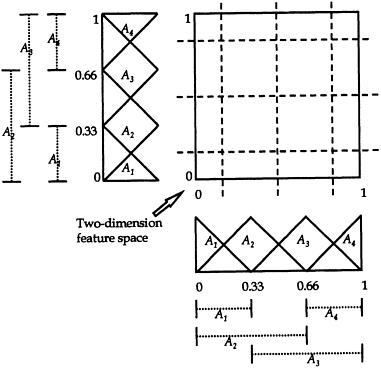81.
| [Cover] [Contents] [Index] |
Page 170
equal to 4 is shown in Figure 4.12 in which, according to Equation (4.39), the membership function centres are 0, 0.33, 0.66 and 1, respectively, λ is computed as 0.33, and a total of sixteen fuzzy subspaces are generated. Note that this classification method generates a unique set of rules for each fuzzy subspace. Each rule in the fuzzy subspace takes the following form:
IF s1 is in Ai and s2 is in Aj
THEN pixel s belongs to class cij with strength wij
where s1 and s2 are the input features for pixel s, and Ai and Aj (1≤i, j ≤k) are fuzzy subspaces on both dimensions, respectively. The class cij and rule strength wij based upon the fuzzy rule are determined by the training data. The procedure for generating fuzzy rules in the subspace ij is shown in Figure 4.13a. The first step in Figure 4.13a is to calculate the weighting parameter βx for each class x using the procedure described in Equation (4.31). We then choose the class cij according to its maximal weights among all classes. The rule in fuzzy subspace ij is then generated with strength wij calculated in step (3).
For example, in the two-dimensional case, two classes and two fuzzy partitions are generated for each dimension, using Equations (4.38) and

Figure 4.12 An example of fuzzy partitions with k=4 results in total sixteen fuzzy subspaces.
| [Cover] [Contents] [Index] |
EAN: 2147483647
Pages: 354
- Article 100 Definitions
- Article 332 Mineral-Insulated, Metal-Sheathed Cable Type MI
- Article 426: Fixed Outdoor Electric De-Icing and Snow-Melting Equipment
- Annex C. Conduit and Tubing Fill Tables for Conductors and Fixture Wires of the Same Size
- Example No. D5(a) Multifamily Dwelling Served at 208Y/120 Volts, Three Phase